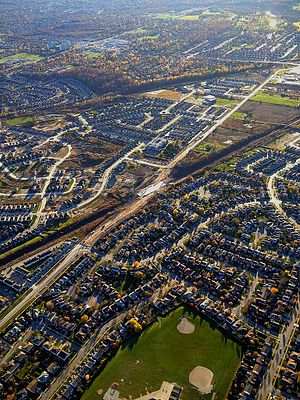 |
| English: The City of London skyline as viewed toward the north-west from the top floor viewing platform of London City Hall on the southern side of the Thames. In the foreground: Dixie Queen and Millennium Time at Tower Millennium Pier. This is a 5 segment panoramic image taken by myself with a Canon 5D and 24-105mm f/4L IS lens. (Photo credit: Wikipedia) |
Assessment of the climate preparedness of 30 urban areas in the UK(Abstract, Oliver Heidrich, Richard J. Dawson, Diana Reckien, Claire L. Walsh, Climae Change, July 2013)
Also quoted here: Planning by Postcode: How Prepared Are Cities for Climate Change?(Science News, Aug. 12, 2013)
Today we review a research report on the state of climate change planning by 30 cities in the UK. Results indicated more progress than in many American or Canadian cities with a consensus on the threat and almost all had a strategy to deal with it and had set targets to reduce carbon emissions. Where there were differences lay in the definition of specific targets and time frames. The country’s capital, London, to little surprise from those who follow urban planning for climate change, had the most advanced plans with progress on the use of renewable energy and waste management.
Key Quotes:
“The 30 cities chosen for the study [representing ~28 % of the UK’s population] were those selected as part of the European Urban Audit database”
" all of them acknowledged that climate change was a threat and all except two had a strategy or policy in place to reduce emissions and also adapt to cope better with future weather patterns, in particular flooding,"
" a plan is only any good if you implement it and then assess it to see how effective it has been, this requires a long term investment in the strategies…in many cities this wasn't happening.. very often, no-one was monitoring to see whether it made a difference or had actually made things worse.”
“London was found to have one of the most advanced strategies in place, mitigating the impact on climate change through, for example, energy efficiency and saving, increasing the use of renewables, waste management and the introduction of greener modes of transport.”
“Almost all cities had set targets for reducing CO2 emissions although quite a few would not commit to an actual target, figure or timescale, rendering them meaningless.. Emissions reduction targets ranged from 10 %–80 % with differing baselines, timeframes and scopes, for defining and meeting these targets”
"What this research highlights more than anything is the huge variations in the state of readiness for climate change across the UK, and the method of assessing the preparedness of cities can easily be applied to cities in other countries.”






















































